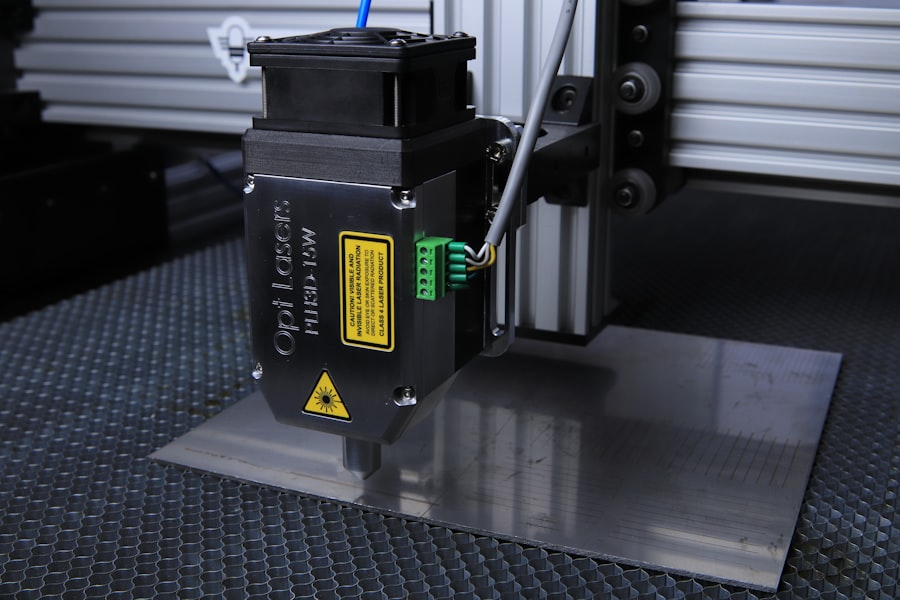Laser hair removal is a popular cosmetic procedure that uses a concentrated beam of light (laser) to remove unwanted hair. The laser emits a light that is absorbed by the pigment (melanin) in the hair. This light energy is converted to heat, which damages the hair follicles, inhibiting future hair growth. The procedure is commonly used to remove hair from the face, legs, arms, underarms, bikini line, and other areas. It is a safe and effective way to achieve long-term hair reduction, with many people experiencing permanent hair loss after a series of treatments.
Laser hair removal is a non-invasive procedure that offers a long-term solution to unwanted hair. It is a popular choice for those who are tired of the constant maintenance of shaving, waxing, or plucking. The procedure can be performed on almost any area of the body, and it is suitable for both men and women. Laser hair removal is a convenient and effective way to achieve smooth, hair-free skin, and it has become increasingly popular in recent years as more people seek a permanent solution to their unwanted hair woes.
Key Takeaways
- Laser hair removal is a cosmetic procedure that uses a concentrated beam of light to remove unwanted hair.
- The laser targets the pigment in the hair follicle, damaging it and inhibiting future hair growth.
- Laser hair removal is generally safe when performed by a qualified and experienced professional.
- Good candidates for laser hair removal are those with light skin and dark hair, as the laser targets the pigment in the hair.
- Common treatment areas for laser hair removal include the legs, underarms, bikini line, face, and back.
- Multiple sessions are usually needed for optimal results, as hair grows in different cycles.
- Before treatment, patients should avoid sun exposure and certain hair removal methods, and after treatment, they may experience temporary redness and swelling.
How Does Laser Hair Removal Work?
Laser hair removal works by targeting the pigment in the hair follicles. The laser emits a light that is absorbed by the melanin in the hair, which then converts to heat. This heat damages the hair follicle, inhibiting future hair growth. The procedure effectively reduces the number of actively growing hairs in the treated area, resulting in long-term hair reduction.
During the procedure, the technician will use a handheld device to deliver the laser pulses to the targeted area. The sensation is often described as a mild stinging or snapping feeling, but most people find it tolerable. The length of the treatment will depend on the size of the area being treated, with smaller areas such as the upper lip taking only a few minutes, while larger areas like the legs may take up to an hour.
Laser hair removal is most effective on individuals with light skin and dark hair, as the contrast between the skin and hair color allows the laser to more effectively target the hair follicles. However, advancements in technology have made it possible for people with darker skin tones to also benefit from laser hair removal.
Is Laser Hair Removal Safe?
Laser hair removal is considered a safe procedure when performed by a qualified and experienced technician. The procedure has been approved by the FDA for “permanent hair reduction,” meaning that it has been proven to reduce the number of hairs in a given area over time. While some people may experience temporary side effects such as redness, swelling, or mild discomfort, these symptoms typically subside within a few hours to a few days.
It is important to choose a reputable and licensed facility for laser hair removal to ensure the safety and effectiveness of the procedure. Additionally, it is crucial to follow all pre- and post-treatment instructions provided by the technician to minimize the risk of complications.
Who is a Good Candidate for Laser Hair Removal?
| Criteria | Description |
|---|---|
| Hair Color | People with dark hair and light skin are the best candidates for laser hair removal as the laser targets the pigment in the hair. |
| Skin Tone | Light skin tones are ideal for laser hair removal as the contrast between the hair and skin makes it easier for the laser to target the hair follicles. |
| Hair Thickness | Thicker, coarser hair responds better to laser treatment compared to finer hair. |
| Health Conditions | Individuals with certain health conditions or taking specific medications may not be suitable candidates for laser hair removal. It’s important to consult with a healthcare professional before undergoing the treatment. |
| Age | While there is no specific age limit, adults with fully developed hair follicles are better candidates for laser hair removal. |
Laser hair removal is suitable for both men and women who are looking for a long-term solution to unwanted hair. Ideal candidates for laser hair removal are those with light skin and dark hair, as the contrast between the skin and hair color allows the laser to more effectively target the hair follicles. However, advancements in technology have made it possible for people with darker skin tones to also benefit from laser hair removal.
It is important for candidates to have realistic expectations about the results of laser hair removal. While the procedure can significantly reduce the amount of unwanted hair, it may not result in complete hair removal. Multiple sessions are typically required to achieve optimal results, and some maintenance treatments may be necessary to sustain the effects.
Candidates should also be in good overall health and have no active skin infections or conditions in the area to be treated. It is important to discuss any medical conditions or medications with the technician before undergoing laser hair removal to ensure that it is safe for you.
What Areas of the Body Can be Treated with Laser Hair Removal?
Laser hair removal can be performed on almost any area of the body where unwanted hair is present. Common treatment areas for women include the face, legs, arms, underarms, bikini line, and back. For men, popular treatment areas include the back, chest, shoulders, neck, and face.
The face is one of the most common areas for laser hair removal treatment, with many people seeking to remove unwanted facial hair on the upper lip, chin, and cheeks. The legs and bikini line are also popular treatment areas for women who want to achieve smooth, hair-free skin without the hassle of shaving or waxing.
For men, laser hair removal is often used to reduce unwanted hair on the back, chest, and shoulders. Many men find that laser hair removal provides a long-term solution to excessive body hair, allowing them to feel more confident and comfortable in their own skin.
How Many Sessions are Needed for Laser Hair Removal?

The number of sessions needed for laser hair removal can vary depending on several factors, including the individual’s skin type, hair color, and coarseness of the hair. Most people will require multiple sessions to achieve optimal results, as laser hair removal is most effective on hairs that are in the active growth phase.
On average, most individuals will need anywhere from 6-8 sessions spaced 4-6 weeks apart to achieve significant hair reduction. After completing the initial series of treatments, some maintenance sessions may be necessary to sustain the results.
It is important to follow the recommended treatment schedule provided by the technician to ensure that you achieve the best possible results from laser hair removal. Skipping sessions or extending the time between treatments can compromise the effectiveness of the procedure.
What to Expect Before, During, and After Laser Hair Removal Treatment
Before undergoing laser hair removal treatment, it is important to schedule a consultation with a qualified technician to discuss your goals and expectations. During this consultation, the technician will assess your skin type and hair color to determine if you are a good candidate for laser hair removal. They will also provide you with pre-treatment instructions to follow in the days leading up to your first session.
During the treatment, you can expect to feel a mild stinging or snapping sensation as the laser pulses are delivered to the targeted area. Most people find this sensation tolerable, but if you are concerned about discomfort, you can discuss options for numbing cream or other pain management techniques with your technician.
After each session, you may experience some redness and swelling in the treated area. These symptoms typically subside within a few hours to a few days. It is important to follow all post-treatment instructions provided by your technician to ensure proper healing and minimize the risk of complications.
In conclusion, laser hair removal is a safe and effective way to achieve long-term reduction of unwanted hair. The procedure works by targeting the pigment in the hair follicles with a concentrated beam of light (laser), which converts to heat and damages the follicles, inhibiting future hair growth. Ideal candidates for laser hair removal are those with light skin and dark hair, although advancements in technology have made it possible for people with darker skin tones to also benefit from the procedure. Multiple sessions are typically required to achieve optimal results, and some maintenance treatments may be necessary to sustain the effects. Before undergoing laser hair removal treatment, it is important to schedule a consultation with a qualified technician to discuss your goals and expectations and ensure that you are well-informed about what to expect before, during, and after each session.
If you’re considering laser hair removal, you probably have a lot of questions. From understanding the effectiveness of laser hair removal on different body areas to its suitability for men’s facial hair and its potential to address “strawberry legs,” there’s a lot to consider. For a comprehensive review of laser hair removal on medium areas, including insights on the process and results, check out this article from Advanced Aesthetics Medispa. Read more here.
FAQs
What is laser hair removal?
Laser hair removal is a cosmetic procedure that uses a concentrated beam of light (laser) to remove unwanted hair. The laser targets the pigment in the hair follicle, damaging it and inhibiting future hair growth.
How does laser hair removal work?
During the procedure, the laser emits a light that is absorbed by the pigment in the hair follicles. This damages the follicle and inhibits future hair growth. Multiple sessions are usually required to achieve long-term hair reduction.
Is laser hair removal permanent?
Laser hair removal can lead to long-term hair reduction, but it is not always permanent. Some hair may grow back over time, but it is typically finer and lighter in color.
What areas of the body can be treated with laser hair removal?
Laser hair removal can be used to treat unwanted hair on various areas of the body, including the face, legs, arms, underarms, bikini line, and back.
Is laser hair removal safe?
When performed by a qualified and experienced professional, laser hair removal is generally considered safe. However, there are potential risks and side effects, such as skin irritation, redness, and changes in skin pigmentation.
Who is a good candidate for laser hair removal?
Laser hair removal is most effective for individuals with light skin and dark hair, as the laser targets the pigment in the hair follicle. It may be less effective for individuals with light hair or dark skin.
How many laser hair removal sessions are needed?
The number of sessions needed for laser hair removal varies depending on the individual’s hair type, skin color, and the area being treated. On average, multiple sessions spaced several weeks apart are required to achieve long-term hair reduction.
What should I expect during a laser hair removal session?
During a laser hair removal session, the area to be treated will be cleaned and a cooling gel may be applied. The laser will then be used to target the hair follicles, emitting a light that may cause a snapping or stinging sensation. After the session, the treated area may be red and sensitive.






